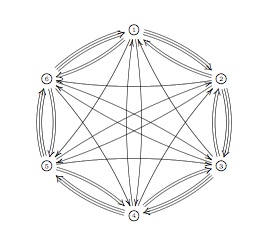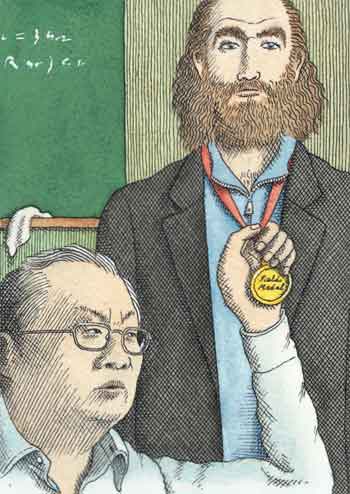Last time we
have seen that the _coalgebra of distributions_ of an affine smooth
variety is the direct sum (over all points) of the dual to the etale
local algebras which are all of the form $\mathbb{C}[[
x_1,\ldots,x_d ]] $ where $d $ is the dimension of the
variety. Generalizing this to _non-commutative_ manifolds, the first
questions are : “What is the analogon of the power-series algebra?” and
do all ‘points’ of our non-commutative manifold do have such local
algebras? Surely, we no longer expect the variables to commute, so a
non-commutative version of the power series algebra should be
$\mathbb{C} \langle \langle x_1,\ldots,x_d \rangle \rangle $,
the ring of formal power series in non-commuting variables. However,
there is still another way to add non-commutativity and that is to go
from an algebra to matrices over the algebra. So, in all we would expect
to be our _local algebras_ at points of our non-commutative manifold to
be isomorphic to $M_n(\mathbb{C} \langle \langle x_1,\ldots,x_d
\rangle \rangle) $ As to the second question : _qurves_ (that is,
the coordinate rings of non-commutative manifolds) do have such algebras
as local rings provided we take as the ‘points’ of the non-commutative
variety the set of all _simple_ finite dimensional representations of
the qurve. This is a consequence of the _tubular neighborhood theorem_
due to [Cuntz](http://wwwmath.uni-muenster.de/u/cuntz/cuntz.html) and
[Quillen](http://www-history.mcs.st-andrews.ac.uk/Mathematicians/Quillen.html). In more details : If A is a qurve, then a simple
$n $-dimensional representation corresponds to an epimorphism
$\pi~:~A \rightarrow S = M_n(\mathbb{C}) $ and if we take
$\mathfrak{m}=Ker(\pi) $, then
$M=\mathfrak{m}/\mathfrak{m}^2 $ is an $S $-bimodule and
the $\mathfrak{m} $-adic completion of A is isomorphic to the
completed tensor-algebra $\hat{T}_S(M) \simeq M_n(\mathbb{C}
\langle \langle x_1,\ldots,x_d \rangle \rangle) $ In contrast with
the commutative case however where the dimension remains constant over
all points, here the numbers n and d can change from simple to simple.
For n this is clear as it gives the dimension of the simple
representation, but also d changes (it is the local dimension of the
variety classifying simple representations of the same dimension). Here
an easy example : Consider the skew group algebra $A =
\mathbb{C}[x] \star C_2 $ with the action given by sending $x
\mapsto -x $. Then A is a qurve and its center is
$\mathbb{C}[y] $ with $y=x^2 $. Over any point $y
\not= 0 $ there is a unique simple 2-dimensional representation of A
giving the local algebra $M_2(\mathbb{C}[[y]]) $. If
$y=0 $ the situation is more complicated as the local structure
of A is given by the algebra $\begin{bmatrix} \mathbb{C}[[y]] &
\mathbb{C}[[y]] \\ (y) & \mathbb{C}[[y]] \end{bmatrix} $ So, over
this point there are precisely 2 one-dimensional simple representations
corresponding to the maximal ideals $\mathfrak{m}_1 =
\begin{bmatrix} (y) & \mathbb{C}[[y]] \\ (y) & \mathbb{C}[[y]]
\end{bmatrix}~\qquad \text{and}~\qquad \mathfrak{m}_2 = \begin{bmatrix}
\mathbb{C}[[y]] & \mathbb{C}[[y]] \\ (y) & (y) \end{bmatrix} $ and
both ideals are idempotent, that is $\mathfrak{m}_i^2 =
\mathfrak{m}_i $ whence the corresponding bimodule $M_i =
0 $ so the local algebra in either of these two points is just
$\mathbb{C} $. Ok, so the comleted local algebra at each point
is of the form $M_n(\mathbb{C}\langle \langle x_1,\ldots,x_d \rangle
\rangle) $, but what is the corresponding dual coalgebra. Well,
$\mathbb{C} \langle \langle x_1,\ldots,x_d \rangle \rangle $ is
the algebra dual to the _cofree coalgebra_ on $V = \mathbb{C} x_1 +
\ldots + \mathbb{C}x_d $. As a vectorspace this is the
tensor-algebra $T(V) = \mathbb{C} \langle x_1,\ldots,x_d
\rangle $ with the coalgebra structure induced by the bialgebra
structure defined by taking all varaibales to be primitives, that is
$\Delta(x_i) = x_i \otimes 1 + 1 \otimes x_i $. That is, the
coproduct on a monomial gives all different expressions $m_1 \otimes
m_2 $ such that $m_1m_2 = m $. For example,
$\Delta(x_1x_2) = x_1x_2 \otimes 1 + x_1 \otimes x_2 + 1 \otimes
x_1x_2 $. On the other hand, the dual coalgebra of
$M_n(\mathbb{C}) $ is the _matrix coalgebra_ which is the
$n^2 $-dimensional vectorspace $\mathbb{C}e_{11} + \ldots +
\mathbb{C}e_{nn} $ with comultiplication $\Delta(e_{ij}) =
\sum_k e_{ik} \otimes e_{kj} $ The coalgebra corresponding to the
local algebra $M_n(\mathbb{C}\langle \langle x_1,\ldots,x_d \rangle
\rangle) $ is then the tensor-coalgebra of the matrix coalgebra and
the cofree coalgebra. Having obtained the coalgebra at each point
(=simple representation) of our noncommutative manifold one might think
that the _coalgebra of non-commutative distributions_ should be the
direct sum of all this coalgebras, summed over all points, as in the
commutative case. But then we would forget about a major difference
between the commutative and the non-commutative world : distinct simples
can have non-trivial extensions! The mental picture one might have
about simples having non-trivial extensions is that these points lie
‘infinitesimally close’ together. In the $\mathbb{C}[x] \star
C_2 $ example above, the two one-dimensional simples have
non-trivial extensions so they should be thought of as a cluster of two
infinitesimally close points corresponding to the point $y=0 $
(that is, this commutative points splits into two non-commutative
points). Btw. this is the reason why non-commutative algebras can be
used to resolve commutative singularities (excessive tangents can be
split over several non-commutative points). While this is still pretty
harmless when the algebra is finite over its center (as in the above
example where only the two one-dimensionals have extensions), the
situation becomes weird over general qurves as ‘usually’ distinct
simples have non-trivial extensions. For example, for the free algebra
$\mathbb{C}\langle x,y \rangle $ this is true for all simples…
So, if we want to continue using this image of points lying closely
together this immediately means that non-commutative ‘affine’ manifolds
behave like compact ones (in fact, it turns out to be pretty difficult
to ‘glue’ together qurves into ‘bigger’ non-commutative manifolds, apart
from the quiver examples of [this old
paper](http://www.arxiv.org/abs/math.AG/9907136)). So, how to bring
this new information into our coalgebra of distributions? Well, let’s
repeat the previous argument not with just one point but with a set of
finitely many points. Then we have a _semi-simple algebra_ quotient
$\pi~:~A \rightarrow S = M_{n_1}(\mathbb{C}) \oplus \ldots \oplus
M_{n_k}(\mathb{C}) $ and taking again
$\mathfrak{m}=Ker(\pi) $ and
$M=\mathfrak{m}/\mathfrak{m}^2 $, then $M $ is again an
S-bimodule. Now, any S-bimodule can be encoded into a _quiver_ Q on k
points, the number of arrows from vertex i to vertex j being the number
of components in M of the form $M_{n_i \times
n_j}(\mathbb{C}) $. Again, it follows from the tubular neighborhood
theorem that the $\mathfrak{m} $-adic completion of A is
isomorphic to the completion of an algebra Morita equivalent to the
_path algebra_ $\mathbb{C} Q $ (being the tensor algebra
$T_S(M) $). As all the local algebras of the points are
quotients of this quiver-like completion, on the coalgebra level our
local coalgebras will be sub coalgebras of the coalgebra which is
co-Morita equivalent (and believe it or not but coalgebraists have a
name for this : _Takeuchi equivalence_) to the _quiver coalgebra_ which
is the vectorspace of the path algebra $\mathbb{C} Q $ with
multiplication induced by making all arrows from i to j skew-primitives,
that is, $\Delta(a) = e_i \otimes a + a \otimes e_j $ where the
$e_i $ are group-likes corresponding to the vertices. If all of
ths is a bit too much co to take in at once, I suggest the paper by Bill
Chin [A brief introduction to coalgebra representation
theory](http://condor.depaul.edu/~wchin/crt.pdf#search=%22%22A%20brief%20introduction%20to%20coalgebra%20representation%20theory%22%22). The
_coalgebra of noncommutative distributions_ we are after at is now the
union of all these Takeuchi-equivalent quiver coalgebras. In easy
examples such as the $\mathbb{C}[x] \star C_2 $-example this
coalgebra is still pretty small (the sum of the local coalgebras
corresponding to the local algebras $M_2(\mathbb{C}[[x]]) $
summed over all points $y \not= 0 $ summed with the quiver
coalgebra of the quiver $\xymatrix{\vtx{} \ar@/^/[rr] & & \vtx{}
\ar@/^/[ll]} $ In general though this is a huge object and we would
like to have a recipe to construct it from a manageable _blue-print_ and
that is what we will do next time.

